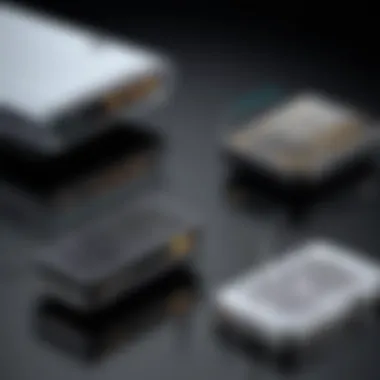Exploring Ultra Wide Band Radio: Functions & Applications


Intro
Ultra wide band (UWB) radio technology has garnered increasing attention across various sectors in recent years. Its unique capabilities, particularly in precise location tracking and high-speed data transfer, distinguish it from traditional wireless communication methods. In this article, we will explore its various aspects, from hardware specifications to its software functionalities, elucidating how it fits into the broader landscape of communication technologies. Understanding the inner workings and applications of UWB is vital for information technology professionals and tech enthusiasts alike, as it represents a pivotal advancement in the realm of wireless technology.
Hardware Overview
UWB radio technology operates within a wide frequency spectrum, typically between 3.1 and 10.6 GHz. This broad spectrum allows UWB devices to transmit large amounts of data across short distances with minimal interference. What makes this technology particularly compelling is its ability to function effectively within crowded frequency environments, a significant limitation for narrowband systems.
Specifications
The specifications of UWB devices can vary based on their design and intended use. Typical specifications include:
- Frequency Range: 3.1 GHz to 10.6 GHz.
- Bandwidth: Greater than 500 MHz, offering capability for high-speed data transmission.
- Transmit Power: Limited to -41.3 dBm/MHz to prevent interference with other services.
- Modulation Techniques: Techniques such as pulse modulation or BPSK may be used to enhance data integrity.
These particulars ensure that UWB systems maintain compliance with stringent regulatory standards while offering exceptional performance.
Performance Metrics
When evaluating the performance of UWB technology, several key metrics must be considered:
- Data Rate: UWB can achieve data rates up to 480 Mbps, facilitating swift file transfers in applications like multimedia streaming and large file sharing.
- Range: Although UWB is primarily designed for short-range communication, it can reliably operate within 10 to 100 meters.
- Precision: UWB technology boasts accuracy within 10 centimeters in spatial positioning, which finds utility in various applications from industrial automation to consumer devices.
A deeper understanding of these performance metrics allows developers and engineers to make informed decisions regarding implementation and design.
Software Analysis
The software elements of UWB technology play a crucial role in defining its user experience and overarching functionality. In this section, we will explore the key features and the user interface aspects of UWB systems.
Features and Functionality
UWB solutions are equipped with several noteworthy features that enhance their appeal for a broad array of applications:
- Real-time Locationing: UWB technology allows for precision tracking in environments where GPS is unreliable, such as indoors.
- High Data Throughput: This feature is critical in enabling applications like wireless video streaming and real-time data access.
- Low Power Consumption: Devices using UWB tend to achieve longer battery life, an advantage increasingly sought in mobile technologies.
This suite of features makes UWB an attractive option for developers looking to create responsive and efficient wireless systems.
User Interface and Experience
An effective user interface (UI) in UWB applications is crucial for maximizing user engagement and operational efficiency. Key considerations include:
- Simplicity: A clean and intuitive interface enables users to navigate functionalities with ease.
- Customization: Allowing users to adjust settings to fit their specific needs and preferences enhances usability.
- Feedback Mechanisms: Providing users with timely responses and updates on system performance contributes to an overall positive experience.
In consideration of these aspects, it is essential for software designers to maintain a user-focused approach to maximize the effectiveness of UWB technology application.
"The advancement in UWB technology is setting the stage for various innovative applications, particularly in the Internet of Things (IoT) realm."
Foreword to Ultra Wide Band Technology
Ultra Wide Band (UWB) technology has gained significant attention in recent years due to its unique characteristics and capabilities. Understanding UWB is crucial for IT professionals and tech enthusiasts as it represents a new frontier in wireless communication, offering advantages in speed, accuracy, and versatility.
Definition of Ultra Wide Band Radio
Ultra Wide Band radio refers to a wireless communication method that uses a large bandwidth of frequency channels, typically exceeding 500 MHz. Unlike traditional narrowband systems, UWB transmits data by sending very short radio pulses over a broad frequency range. This unique approach allows for high-speed data transfer and precise positioning capabilities.
The key feature of UWB is its ability to operate in crowded frequency bands while minimizing interference. Its low energy consumption and effectiveness in indoor environments make it attractive for various applications. In essence, UWB enables faster communication with less power, a crucial factor for modern devices requiring efficient performance.
Historical Background of UWB
The concept of Ultra Wide Band technology is not new. Its origins trace back to the late 1960s when researchers began exploring the potential of short-duration pulses. During the 1990s, the Federal Communications Commission (FCC) authorized the use of UWB, marking a significant milestone in its development. Researchers and engineers saw it as an opportunity to revolutionize wireless communications.


The 2000s witnessed the beginning of practical applications, especially in systems designed for real-time location tracking and secure communications. As industries such as automotive and healthcare increasingly incorporated connected technology, UWB's importance grew. Today, its relevance continues to expand with the rise of the Internet of Things and smart devices, positioning UWB as a key player in the future of wireless technologies.
Technical Principles of UWB Radio
Understanding the technical principles of Ultra Wide Band (UWB) radio is essential to appreciate its functionality and wide-ranging applications. This section examines the core elements of UWB technology, including its frequency range, modulation techniques, and the signal processing involved. These principles not only define how UWB works but also highlight its unique capabilities that set it apart from other wireless technologies.
Frequency Range and Bandwidth
UWB operates across a very broad frequency spectrum, typically defined as being wider than 500 megahertz or occupying a frequency range of 3.1 to 10.6 gigahertz. This extensive bandwidth allows UWB to transmit data at exceptionally high rates and with minimal power. The significance of this frequency range is profound; it enables data transfer over short distances with accurate localization, making it ideal for applications like indoor positioning systems.
The wide bandwidth also translates to effective multipath mitigation. In environments where signals might reflect off surfaces, UWB systems maintain reliability as the short duration of each pulse helps in distinguishing between direct and reflected signals. This characteristic is particularly useful in scenarios where precise timing is crucial.
Modulation Techniques
UWB employs various modulation techniques, mainly pulse-based methods. The most commonly used is On-Off Keying (OOK), but other techniques like Pulse Position Modulation (PPM) are also prevalent. These methods enable the encoding of data into short pulses, optimizing power efficiency and bandwidth utilization. By transmitting information in pulses rather than continuous waves, UWB minimizes interference with other wireless systems operating nearby.
The use of short-duration pulses means that UWB signals can be easily distinguished from noise, enhancing performance in congested radio environments. Such modulation schemes are key to the technology's ability to support a wide array of applications from simple data transmission to complex systems requiring high fidelity.
Signal Processing in UWB Systems
Signal processing is a fundamental aspect of UWB systems. It encompasses techniques for detecting, estimating, and interpreting the incoming signals, which, due to their wide bandwidth, can contain a vast amount of data. UWB signal processing techniques include methods like matched filtering and time-domain signal processing.
Matched filtering helps to maximize the signal-to-noise ratio, which is critical for achieving robust communication links. Time-domain processing is particularly effective given UWB’s ultra-short pulses, allowing systems to operate effectively even in challenging environments.
Moreover, advanced algorithms improve the ability of UWB systems to handle interference and maintain connectivity. These signal processing techniques are crucial for applications such as healthcare monitoring and automotive systems, where decision-making must occur in real-time based on incoming data.
UWB’s technical principles underpin its extensive versatility, making it a significant player in the future of wireless communications?
Understanding these technical principles provides IT professionals and tech enthusiasts with the necessary insights to explore the evolving role of UWB in modern technologies.
Through this examination, we appreciate not only the scientific foundation of UWB radio but also the implications for future developments and applications.
Comparative Analysis of Wireless Technologies
Comparing wireless technologies is essential for understanding the unique advantages and applications of ultra wide band (UWB) radio. Each technology has its strengths, weaknesses, and suitable use cases. By exploring how UWB compares to other modes of communication, IT professionals can make informed decisions when selecting the most appropriate solution for a given situation. This analysis serves not only to highlight UWB's distinct features but also provides a wider context within current technology trends. Knowing the key characteristics of each wireless technology enables users to leverage synergies and mitigate disadvantages.
UWB vs. Zigbee
Ultra wide band and Zigbee both serve specific niches within wireless communication. UWB has a much wider bandwidth, enabling high data transfer rates. It operates over a range from 3.1 to 10.6 GHz, achieving multi-gigabit speeds. In contrast, Zigbee operates on the 2.4 GHz frequency and is limited to lower data rates around 250 Kbps.
A notable difference is the application focus. Zigbee excels in low-power, short-range scenarios, primarily suited for sensor networks in smart homes and industrial automation.
On the other hand, UWB finds its applications in real-time location systems, where precision is crucial. For example, UWB's range is more versatile, making it suitable for longer distances with lower latency.
UWB vs. Bluetooth
Bluetooth technology is widely recognized for connecting devices like headphones and smartphones. It is effective for short-range communication and works well in consumer electronics. UWB, however, offers much finer spatial measurements and higher throughput. It can support multiple devices at once effectively without lag.
The range and penetration capabilities are also critical points. Bluetooth usually works at ranges up to 100 meters, whereas UWB can extend further, depending on the environment and device configuration.
Furthermore, Bluetooth’s average data rate is substantially lower than UWB; UWB can reach up to 1 Gbps under optimal conditions. This makes UWB a better fit for applications requiring intensive data exchange like high-definition video streaming.
UWB vs. Wi-Fi
Wi-Fi is another prominent wireless communication technology. Primarily focused on local area networks, Wi-Fi can deliver high-throughput wireless internet access. However, UWB's real-time data transmission capabilities differentiate it from Wi-Fi.
UWB provides better precision in positioning applications which is not achievable with standard Wi-Fi. While Wi-Fi can support several devices, it is less efficient in environments requiring strict timing and lower latency, such as asset tracking or indoor navigation.
Additionally, Wi-Fi’s interference susceptibility in crowded networks can impede performance, while UWB operates effectively in dense environments due to its low power spectral density.


Understanding the differences between UWB and other wireless technologies aids in determining the most effective solution for specific requirements. Each technology complements various applications, but their suitability relies on understanding their unique strengths and limitations.
In summary, the comparative analysis of wireless technologies encapsulated UWB against Zigbee, Bluetooth, and Wi-Fi, demonstrating the significance of choosing the right technology for modern applications that span everyday consumer use to advanced industrial deployments.
Applications of Ultra Wide Band Radio
The applications of Ultra Wide Band (UWB) radio technology showcase its versatility and effectiveness across several industries. As various sectors seek more efficient communication methods and more accurate positioning capabilities, UWB presents a compelling solution. This section explores the significant applications of UWB radio, emphasizing how its unique features contribute to advancements in technology and drive innovation in different domains.
Indoor Positioning Systems
One of the most promising applications of UWB radio is in indoor positioning systems. Unlike traditional GPS, which struggles in indoor environments, UWB provides precise location data. Utilizing the time-of-flight approach, UWB measures how long a signal takes to travel between devices. This characteristic enables accurate positioning within inches, which is essential for various use cases.
Many industries, such as retail, logistics, and healthcare, are beginning to adopt UWB for navigational aids. For example, in a hospital, this technology can help track medical equipment and personnel efficiently. In retail, businesses can enhance the shopping experience by guiding customers to specific products or areas using real-time location data. This efficiency can lead to increased customer satisfaction and operational effectiveness.
Automotive Systems
UWB also plays a crucial role in the automotive sector, where its high precision and low power consumption are invaluable. Modern vehicles are increasingly equipped with smart features that require secure communication and accurate location data to function correctly. UWB technology can facilitate keyless entry systems and vehicle tracking solutions. Moreover, its ability to operate effectively in dense environments makes it ideal for applications like collision avoidance systems.
Brands are exploring the integration of UWB into automated parking assistance features. This application can provide drivers with accurate distance measurements, simplifying the parking process and enhancing safety. Overall, UWB's potential in automotive systems is driving the development of safer and smarter vehicles.
Healthcare Solutions
In the healthcare field, UWB technology offers significant benefits in enhancing patient care and operational efficiency. Real-time tracking of medical assets can reduce the time spent searching for equipment, allowing healthcare professionals to focus on patient needs. UWB can also monitor the movement of patients within a facility, ensuring improved safety and timely response in emergencies.
Moreover, UWB's capabilities can extend to wearable health devices. Such devices can monitor a patient's vital signs and transmit this information with minimal delay, providing healthcare providers with critical data for prompt decision-making. Given the increasing emphasis on remote health monitoring, UWB is set to play an integral role in shaping future healthcare solutions.
Smart Homes and IoT Integration
The integration of UWB technology into smart homes represents a significant shift towards more streamlined and efficient living environments. UWB facilitates seamless connectivity among devices, allowing for better home automation systems. This technology can enable precise location tracking for devices, enhancing security and usability.
For example, smart locks can utilize UWB for secure keyless entry, while other devices can adjust settings based on the user's location within the home. The ability of UWB to operate effectively in high-interference environments makes it suitable for home networks with numerous connected devices. This integration can lead to improved user experiences and greater operational efficiency in smart home applications.
Regulatory Framework Surrounding UWB Technology
The establishment of a regulatory framework for Ultra Wide Band (UWB) technology is critical for its successful integration and advancement. As UWB radio operates over a broad frequency band, it has the potential to interfere with other wireless technologies if not governed appropriately. Regulatory standards ensure that UWB devices can operate harmoniously within the existing spectrum while minimizing disruptions to other services.
Global Regulatory Standards
Globally, there are various standards that govern UWB technology, ensuring its safe deployment across different regions. One of the most notable is the Federal Communications Commission (FCC) regulations in the United States, which were established to permit UWB devices to operate at specific power levels and frequency ranges.
In Europe, the European Telecommunications Standards Institute (ETSI) has developed standards for UWB technologies, providing guidance on compatibility with other technologies and emissions limits. These regulations focus on ensuring a fair operating environment for all wireless technologies while allowing UWB to flourish.
Several key aspects of global regulatory standards include:
- Frequency Allocation: Allocation of specific frequency bands for UWB, ensuring minimal overlap with other technologies.
- Emission Limits: Setting limits on emission power levels to prevent interference.
- Technical Specifications: Defining operational parameters that UWB devices must meet to gain approval in the market.
By adhering to these global standards, manufacturers can facilitate international trade and market accessibility, ensuring that UWB technology can be deployed effectively worldwide.
Certification Processes for UWB Devices
Before UWB devices can enter the market, they must undergo a rigorous certification process to ensure compliance with relevant regulations. This certification usually includes a series of tests and evaluations conducted by accredited laboratories. The testing typically covers the following areas:
- Compliance Testing: Ensuring devices meet regulatory requirements regarding emission limits and frequency usage.
- Interoperability Testing: Verifying that UWB devices can function in the presence of other wireless systems without causing interference.
- Performance Testing: Evaluating the device's capabilities to ensure it meets specified operational criteria, such as data transmission rates and reliability under various conditions.
Certification is crucial for several reasons:
- Market Entry: It allows products to be legally sold and used within various jurisdictions.
- Consumer Confidence: Certified devices provide assurance to consumers that they meet safety and performance standards.
- Innovation Encouragement: A clear certification process encourages manufacturers to innovate by providing them the knowledge that their devices can be successfully verified.
Challenges and Limitations of UWB Radio


Understanding the challenges and limitations of Ultra Wide Band (UWB) radio is crucial for IT professionals and tech enthusiasts alike. These factors significantly influence the deployment, reliability, and effectiveness of UWB technology across various applications. While UWB presents multiple advantages, such as high data rates and precision location tracking, a comprehensive understanding of its shortcomings is essential for informed implementation.
Interference Issues
One of the notable challenges facing UWB technology is the potential for interference. UWB operates in a frequency spectrum that overlaps with numerous other wireless technologies. Devices utilizing Bluetooth, Wi-Fi, and micro wave radars often operate within similar frequencies. This can lead to signal degradation and reduced performance.
- Types of Interference
- Co-channel Interference: This occurs when multiple systems share the same frequency channel, leading to competition for bandwidth.
- Adjacent-channel Interference: This arises when transmissions from nearby channels spill over, affecting UWB performance.
Many UWB applications, particularly in environments with high device density, struggle against these interferences. In indoor locations, where obstacles and reflections can dilute signals, UWB devices may not function optimally. To mitigate interference, it is vital to incorporate advanced signal processing techniques and adhere to regulatory guidelines regarding transmit power and frequency usage.
Range and Penetration Limitations
The signals produced by UWB devices can offer remarkable speed and accuracy. However, their range and penetration capabilities are restricted. UWB technology typically functions best over short distances, often up to 30 meters in indoor settings. As the distance increases, the signal strength diminishes quickly, leading to reduced reliability.
Factors contributing to range limitations are:
- Physical Obstructions: Walls, furniture, and other barriers can significantly attenuate UWB signals, causing gaps in connectivity.
- Signal Dispersion: Due to the wide bandwidth used, signals can disperse rapidly in open environments, reducing effective transmission distance.
Conversely, in open areas without obstacles, UWB can maintain a clearer signal over greater distances. However, this quality does not compensate for its limitations in urban or indoor environments.
Future Trends in Ultra Wide Band Technology
The exploration of future trends in ultra wide band (UWB) technology reveals its growing significance in various sectors. As industries increasingly seek innovative solutions for communication and data transmission, UWB stands out for its low power consumption and high precision capabilities. This trend presents numerous benefits, such as improved data transmission speed and accuracy in positioning services. In the context of this article, understanding these trends helps to grasp how UWB can evolve and shape future technological innovations.
Emerging Applications in Various Industries
Industries are rapidly adopting UWB technology due to its unique capabilities. One significant area of implementation is in healthcare. UWB can enhance patient monitoring systems by providing accurate tracking within a hospital or clinic. These systems can help in emergency rooms, ensuring that personnel locate patients swiftly.
Another sector observing growth in UWB applications is logistics. Companies utilize UWB for real-time asset tracking. It aids in improving supply chain efficiency, reducing loss or theft of goods. Furthermore, UWB is becoming essential in manufacturing and automation, enabling precise location tracking of machinery and tools.
- Healthcare: Real-time monitoring, patient location tracking.
- Logistics: Asset management, supply chain optimization.
- Manufacturing: Tool and machinery tracking.
The Role of UWB in 5G Networks
With the rollout of 5G networks, UWB is positioned to play an invaluable role. The combination of these two technologies promises unprecedented communication capabilities. UWB’s high bandwidth fits well within the 5G framework, facilitating faster data transfer rates. This synergy can optimize bandwidth usage and enhance the reliability of device connectivity.
Advancements in UWB Chipset Technology
The development of UWB chipsets is crucial for realizing the potential of UWB technology. Recent advancements have focused on reducing the size of the chipsets while maximizing performance. This miniaturization allows for integration into smaller devices, promoting widespread adoption in consumer electronics.
Furthermore, the introduction of more efficient designs leads to reduced power consumption. As a result, devices equipped with these chipsets can operate longer on battery power, offering convenience to users. The innovation in chipset technology indicates a shift towards more versatile applications, from smartphones to wearable technology.
Recent trends may also focus on improving security features within UWB chipsets. Enhanced security measures can protect data transmission from unauthorized access, an important consideration as privacy concerns rise amidst expanding IoT networks.
"UWB technology is at a pivotal point. Its future in various industries looks promising, especially at the intersection with emerging technologies like 5G and IoT."
As industries harness the power of UWB, its influence will continue to grow. Keeping abreast of these trends is essential for IT professionals and tech enthusiasts. This understanding creates opportunities to innovate further and apply UWB technology effectively.
Finale
Summary of Key Insights
Ultra Wide Band (UWB) technology presents unique capabilities that differentiate it from traditional wireless communication methods. This article has emphasized the following insights regarding UWB:
- High Bandwidth: UWB can transmit large amounts of data simultaneously, which is vital for applications that demand speed, such as real-time video streaming.
- Low Power Consumption: Compared to other wireless technologies, UWB operates with very low power, making it ideal for battery-powered devices in smart IoT environments.
- Accurate Positioning: The ability of UWB to provide precise location data is crucial in fields like healthcare and automotive systems, where accuracy can enhance safety and efficiency.
- Diverse Applications: UWB's application ranges from indoor positioning systems to healthcare devices, underlining its versatility.
These factors position UWB as a key player in the evolution of wireless technology, especially with the rise of IoT and the integration of devices into daily life.
Final Thoughts on UWB's Future
As we look ahead, the future of Ultra Wide Band appears promising. The technology is likely to play a pivotal role in the rollout of 5G networks, enhancing data transfer rates and connectivity solutions. Also, industries are rapidly adopting UWB due to the increasing need for real-time data and location accuracy.
Furthermore, advancements in UWB chipset technology will reduce costs and improve functionality, making it more accessible to broader applications. The convergence of UWB with emerging technologies like artificial intelligence could lead to innovative solutions that redefine how devices interact.
Overall, UWB stands as a cornerstone of future wireless communication, with its capacity to address current limitations in wireless technologies, making it an essential focus for IT professionals and technology enthusiasts.



